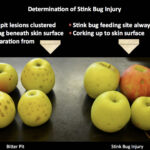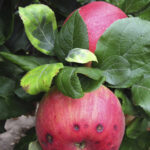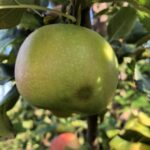In Indiana, our ‘normal’ or average weather is one of extremes, punctuated with an occasional glorious summer day of sun and 76 degrees F. This year has been one of flooding and droughts, freezes and scorching heat. Again. With these weather extremes come physiological disorders and summer fruit rots, for those lucky enough to even have a crop.
Physiological disorders in apples are easily confused with hail injury, disease or insect damage (Fig. 1). Recognizing the different causes of these problems is important to implement the appropriate management to minimize or prevent the problem from occurring next year.
Bitter pit commonly presents during hot weather, and dry spells, particularly on varieties like Gala or Honeycrisp. Symptoms of bitter pit include circular or even irregular sunken spots on the fruit surface, beneath brownish or streaked dead regions (Fig. 2). The affected tissue in these pits is dark and spongy. Those brave enough to taste it may discover that it tastes…bitter, and simply quite terrible, for those wondering. I do the hard experimenting so you don’t have to!
Symptoms of bitter pit may be mistaken for hail damage, bitter rot, or any of the below problems. A key diagnostic feature is that hail usually affects only one side of the fruit, whereas bitter pit is more severe on blossom end of the fruit. Some varieties, like Honeycrisp, are more prone to this disorder, whereas hail will impact (literally) all varieties of fruit. Bitter pit can show up throughout the orchard, not just the edges, like one may observe with insect damage. Lastly, large fruit from trees with light crops are more likely to have bitter pit than trees that were adequately and not over-thinned. Lenticel spot, or lenticel rot are the names given to disorders of apple fruits whose symptom is a small brown or black spot centered on a lenticel. Lenticel spot, per se, is not caused by fungi or bacteria, although the spots may be invaded by opportunistic secondary rot fungi, like the bitter rot, white rot or black rot fungi, while fruit is stored. I have not recovered sufficiently from tasting bitter pit to see if the flavor of lenticel rot is something of diagnostic note.
Cork spot (Fig. 3) is another physiological disorder affecting the outer portion of the fruit. Symptoms begin on the fruit flesh as small dimples or depressions. This disorder begins developing in June, and continues throughout the growth and enlargement of the apple. Lesions enlarge to 1/4 – 1/2 inch corky, discolored areas in the flesh of the apple. Unlike bitter pit, the corky spots may occur anywhere on the apple. It is important to note that all of these problems are only surface blemishes. Unfortunately, their unattractive appearance often reduces the marketability of the fruit.
Bitter pit, lenticel rot and cork spot disorders can be mistaken for brown marmorated stink bug injury (BMSB) (Fig. 1,2). BMSB usually appears around the edges of the orchard, although I do question their literacy skills and their ability to follow directions. BMSB can occur all over the apple, and more around the shoulder than the calyx. There should be a ‘sting’ in the center of the depression—this is a key diagnostic feature.
For those that have had problems with these disorders: Bitter pit, lenticel rot, cork spot and Jonathan spot are complex problem that require an integrated management scheme to reduce the problem to acceptable levels. A history of excessive fertilization [nitrogen (N), potassium (K) or fluctuating soil moisture affecting calcium (Ca)] have all been correlated with bitter pit outbreaks. It is very simple to say “just add more calcium” but the reality is more complex. Calcium isn’t as soluble as potassium or magnesium, and its solubility is very pH dependent, making it less readily available to the plant. High levels of nitrogen, potassium, and magnesium compete with and reduce the fruit uptake of calcium. Furthermore, applications of nitrogen preferentially drive shoot growth over fruit growth, also reducing available calcium. Finally, high levels of available water can increase fruit calcium if shoot growth is not excessive, and drought prevents nutrient uptake that is needed to assure proper fruit development. That said, one study found, at least for ‘Honeycrisp’, the addition of calcium alone was beneficial (Rosenberger et al. 2004). Another nutrient issue on postharvest rots is excessive nitrogen use. Not only is judicious N use prudent to minimizing the risk of fire blight, but excessive N results in fruit that are predisposed to postharvest problems, compared to the lower N counterparts. Finally, in addition to ‘Honeycrisp,’ other susceptible varieties include ‘Baldwin,’ ‘Gala’, ‘Gravenstein,’ ‘Grimes Golden,’ and ‘Northern Spy.’ ‘Golden Delicious’ is considered moderately susceptible, while ‘Delicious’ and ‘Winesap’ are fairly resistant.
At this point, all you can do is plan for next year. Bitter pit, lenticel rot, cork spot and Jonathan spot can be remedied with calcium chloride at 2 pounds per 100 gallons of water (or 1.5 tablespoons per 1 gal. water) applied in four sprays beginning two weeks after full bloom and continuing at 10 to 14-day intervals thereafter to reduce cork spot. At this rate, calcium chloride may be added to pesticide sprays normally used in controlling post-bloom diseases (or insects) affecting fruit. Do NOT apply calcium chloride sprays when temperatures are above 85 degrees F. Also, calcium chloride is highly corrosive—be sure to rinse sprayer thoroughly after use. As nitrogen management is also implicated in this disease, reduce excessive shoot growth by not applying (or greatly minimizing) nitrogen to the soil of apple trees for at least one year. Evaluate results at the end of that season; in the second year, use ½ the recommended amount of N, and evaluate harvest again.
References and additional information:
Bitter pit control in apples. Available at: http://www.omafra.gov.on.ca/english/crops/facts/00-009.htm
Rosenberger, D.A., J.R. Schupp , S.A. Hoying , L. Cheng, and C.B. Watkins. 2004. Controlling Bitter Pit in ‘Honeycrisp’ Apples. HortTechnology 14(3) 342-9.
http://horttech.ashspublications.org/content/14/3/342.full.pdf
Bitter pit versus stink bug. Photo by Peter Jentsch. http://blogs.cornell.edu/jentsch/2014/09/18/bmsb-update-assessing-fruit-damage-at-harvest-is-it-hail-bitter-pit-apple-maggot-or-stink-bug/
- Figure 1. Bitter pit versus stink bug. Photo by Peter Jentsch.
- Figure 2 Lenticel rot. Photo by Janna Beckerman
- Figure 3. Cork spot is often confused with stink bug damage. Photo by Janna Beckerman


